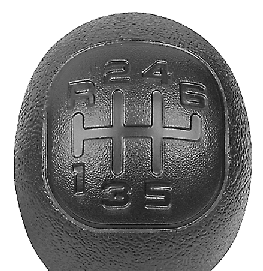Using the Clutch
When you are starting to move the vehicle, it is important to begin with the engine speed at idle. Then start to engage the clutch and listen for an engine speed drop of about 100 rpm. At this point, the clutch is engaging, so you should increase the engine speed and fully engage the clutch. It is important not to increase the engine speed sooner or before the clutch begins its engagement. If you do, you can cause damage to your vehicle.
Double-Clutching
You must use the double-clutching method when you shift an unsynchronized gear set. Disengage the clutch, shift to NEUTRAL and engage the clutch. When upshifting, slow the engine until the engine rpm and road speed match. When downshifting, accelerate the engine until the engine rpm and road speed match. Then quickly disengage the clutch and move the shift lever to the next gear position and engage the clutch.
Eaton® Fuller® Five and Six-Speed Transmissions and TTC Spicer Seven-Speed Transmissions
These transmissions have gears that automatically synchronize when you shift up or down (except FIRST (1) gear on the five-speed and seven-speed transmission which is unsynchronized). Choose the gear that will maintain the road speed you want while keeping the engine above two-thirds of the governed speed. When the engine speed drops below two-thirds of the governed speed, shift into the next lower gear before your engine begins to lug. When you shift down, be sure to double-clutch if required.
ZF Six-Speed Transmission
Here is how to operate your transmission.

This six-speed pattern is unique to GM manual transmissions.
The transmission always repositions the shift lever to NEUTRAL, which is located between FOURTH (4) and FIFTH (5) gear.
To prevent unintentional gear selections, additional force is required to move the shift lever into REVERSE (R) or FIRST (1). Use FIRST (1) when trailer towing, driving with a heavier payload or launching on a grade. Otherwise, start in SECOND (2) gear. Only shift into FIRST (1) when the vehicle has stopped moving.
During the first 500 miles (805 km) of vehicle use, start the vehicle moving in FIRST (1) gear. This allows the clutch components to wear-in properly.
FIRST (1): With the vehicle at a stop, release the brake, press the clutch pedal and shift into FIRST (1). Then, slowly let up on the clutch pedal as you press the accelerator pedal. Only downshift into FIRST (1) when the vehicle has come to a complete stop. If the shift lever will not go into FIRST (1), put the lever in NEUTRAL and let up on the clutch pedal to fully engage the clutch. Press the clutch pedal again. Then, shift into FIRST (1).SECOND (2): With the vehicle at a stop, release the brake, press the clutch pedal and shift into SECOND (2). Then, slowly let up on the clutch pedal as you press the accelerator pedal. With the vehicle moving, press the clutch pedal and upshift into SECOND (2) from FIRST (1) while applying light pressure to the right on the shifter. Then, slowly let up on the clutch pedal as you press the accelerator pedal. If you come to a complete stop and the shift lever will not go into SECOND (2), put the lever in NEUTRAL and let up on the clutch pedal to fully engage the clutch. Press the clutch pedal again. Then, shift into SECOND (2).
THIRD (3): Press the clutch pedal and upshift into THIRD (3). Then, slowly let up on the clutch pedal as you press the accelerator pedal.
FOURTH (4), FIFTH (5) and SIXTH (6): Upshift into the higher forward gears the same way as you do THIRD (3). Slowly let up on the clutch pedal as you press the accelerator pedal.
NEUTRAL: Use this position when you start or idle your engine.
REVERSE (R): To back up, press the clutch pedal. Wait for the vehicle to stop moving and then, shift to REVERSE (R). Let up on the clutch slowly while pressing the accelerator pedal. Also, use REVERSE (R), along with the parking brake, when turning off your engine and parking your vehicle.
Eaton® Fuller® Nine and Ten-Speed Non-Synchronized Manual Transmissions
If your vehicle has one of these transmissions the engine rpm and road speed must match when upshifting and downshifting. The label above the windshield will tell you the operating basics you need to know.
The following are driving tips.
| • | Always choose an initial starting gear suitable for the load and terrain. |
| • | Always use double-clutching procedures when shifting. |
| • | Never move the range shift lever to the LO speed gear position after HI range preselection, or anytime the transmission is in the HI range. |
| • | Never move the range knob or lever with the shift lever in NEUTRAL while the vehicle is moving. |
| • | Never make a range shift while moving in REVERSE (R). |
Clutch Brake (Vehicles with Non-Synchronized Transmission)
A clutch brake is used to stop transmission input shaft rotation so that FIRST (1) or REVERSE (R) gear selection can be initiated when the vehicle is at a standstill and the engine is idling.
Press the clutch pedal all the way down to the floorboard to apply the clutch brake.
When using the clutch brake, disengage the clutch pedal and shift the transmission into either the initial starting gear or REVERSE (R). If the tooth-butting occurs between the clutching teeth, re-engage the clutch while applying light pressure to the shift lever. This will provide for a smooth shift into either FIRST (1) or REVERSE (R) gear.
Notice: Using the clutch brake for shifting into any gear other than 1 (First) or R (Reverse) may cause premature wear of the clutch brake and make gear shift effort more difficult. Do not use the clutch brake for shifting after engaging 1 (First) or R (Reverse).
